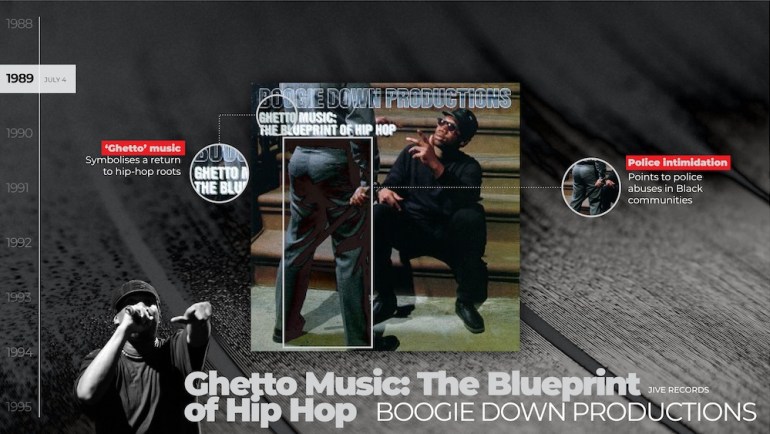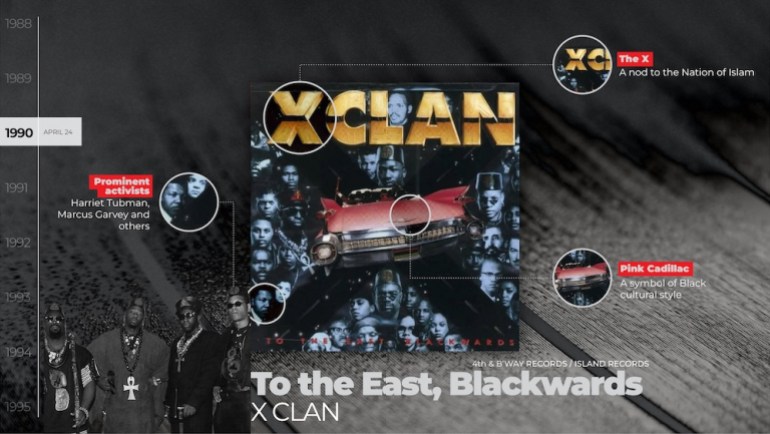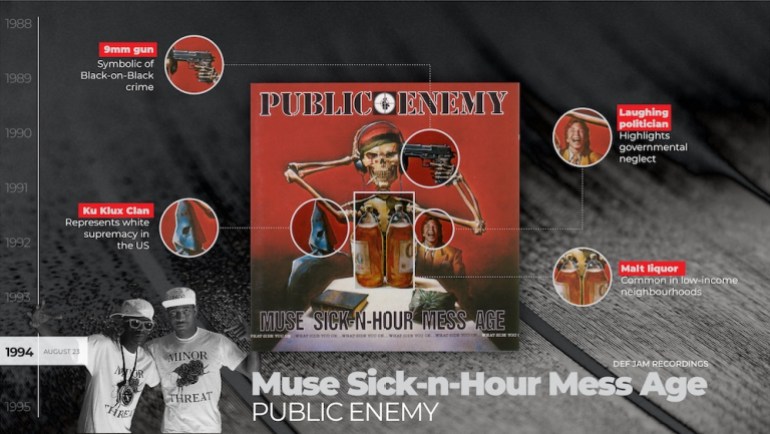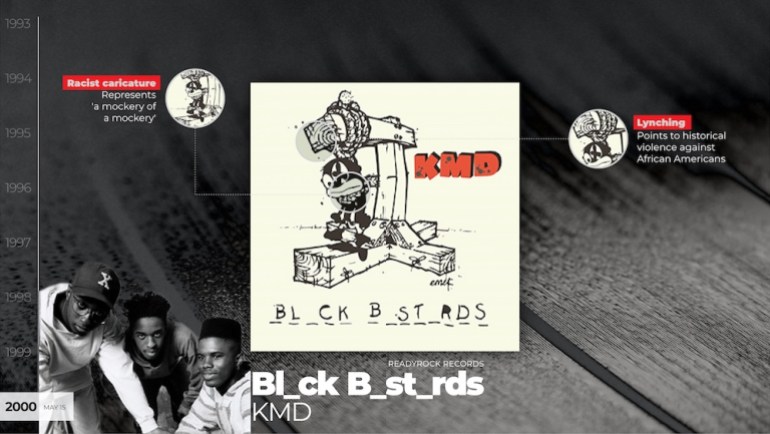[
The intersection of political commentary and hip-hop music is a decades-long custom, beginning with Grandmaster Flash and the Livid 5's “The Message” in 1982. The style's heyday occurred within the Nineteen Nineties when album paintings was an necessary a part of music discovery.
Earlier than streaming dominated the fashionable music ecosystem, followers flocked to document shops to take a look at the most recent releases. Whereas CDs might now be positioned on a single stand inside a grocery store, for earlier generations, document shops included a method to uncover new music, very similar to looking via Spotify or Apple Music at present.
Album covers have been an necessary a part of this expertise. And on the earth of hip-hop, they’ve lengthy been used to ship messages about tradition, politics, and the final worldview of artists.
Right here, Al Jazeera decodes eight album covers from the height period of political hip-hop and explains the photographs and symbols used on every.
Gang Starr, Every day Operation (1992)

Plucking eyebrows: Pictured within the foreground on this cowl of Every day Operation is Guru, who, with DJ Premier, types the hip-hop duo, Gang Starr. Guru's furrowed eyebrows signify an expression of black tradition that was popularized by rapper Massive Daddy Kane.
Malcolm Within the background hangs a portrait of Malcolm X, the Muslim American minister and human rights activist who had a major affect on the world of hip-hop. Within the Nineteen Nineties, lots of his speeches have been reduce and remixed into songs.
Turntables: These are SL-1200 turntables, that are among the many hottest tools utilized by hip-hop DJs. Gang Starr's DJ Premier is among the most prolific and influential producers within the trade.
Influential guide: The guide, Message to the Blackman in America, by Elijah Muhammad, a distinguished chief of Islam, was first revealed in 1965. It launched many individuals within the hip-hop world to Black theology, encouraging ideas of self-determination and group revitalization.
Boogie Down Productions, Ghetto Music: Blueprint of Hip Hop (1989)

“Ghetto” Music: Using the time period “ghetto” to explain poor African American neighborhoods is deliberate. That is defined within the album's liner notes, which condemn materialism within the trade, stating: “Now we have once more discovered it essential to return to our roots – 'The Ghetto' – to make sure purity, expertise. And in making an attempt to retain the mind is usually misplaced.” Maintaining with the Joneses.”
Police menace: The picture of a police officer standing over group member KRS-One signifies an imminent menace. The monitor “Who Protects Us From You?” There are allegations of police abuses in black communities. The identical 12 months the album was launched, the notorious Central Park 5 case broke, wherein 5 youngsters have been wrongly convicted of raping a white lady.
Queen Latifah, Nature of a Sista (1991)

Arabic title: Queen Latifah selected her surname from an Arabic guide of names – “Latifa” means “form” and “light”. The phrase “queen” was added to mirror ladies's notion of their very own future as queens.
Afrocentric Outfit: The focus of this cowl is Queen Latifah's African-inspired headdress, which speaks to the African-centric themes standard in Nineteen Nineties hip-hop. Many artists on this period used symbols to signify Pan-Africanism and black nationalism, together with medallions and clothes embellished with photos of the African continent.
X Clan, To the East, Blackwords (1990)

X: That is an allusion to the Nation of Islam's follow of changing surnames with “X” (akin to Malcolm
lead hand: Members of the
pink cadillac: The pink Cadillac was an emblem of black cultural type and upward mobility. Group member Professor I take into consideration the 1959 Pink Caddy, who was from South Carolina. These guys had a Caddy yearly. It meant one thing to them. We're speaking in regards to the 1959 pink Caddy as a result of it represented a cut-off date. used to do.
Public Enemy, Muse Sick-N-Our Mess Age (1994)

9mm gun: The picture of a 9mm handgun pointed instantly on the cranium symbolizes black-on-black crime, suggesting that such a violence is self-destructive or suicidal.
Laughing politician: This picture highlights authorities neglect of black communities in America. Public Enemy is understood for utilizing provocative and harsh political imagery. On the time of this album's launch in 1994, hip-hop was present process a change from Afrocentric political commentary to what Ice-T known as “actuality rap”, also referred to as “gangster rap”.
Ku Klux Klan: This picture of the hooded Klansman represents white supremacy in America. It’s noteworthy that the Clansman is passively watching the destruction of a skeletal determine, who is taken into account black, as indicated by the pink, black and inexperienced kufi on the cranium.
malt liquor: The 2 40-ounce bottles of malt liquor level to the prevalence of this substance in black neighborhoods, as low cost alcoholic drinks have been marketed to low-income communities.
Ice Dice, Demise Certificates (1991)

American Flag: The nation's flag is draped over the physique, reinforcing the album's criticism of America, with songs addressing points akin to gun possession, racial profiling and the “warfare on medicine”.
uncle Sam: On the duvet of this album, rapper Ice Dice is proven standing over a corpse mendacity on a unclean material, with “Uncle Sam” written on his toe, an emblem of the US authorities. It reveals how American establishments have failed residents.
Frequent, Like Water for Chocolate (2000)

Method: The picture seems to have been taken from a automotive window, highlighting how American society passively views racist social constructions designed to oppress black residents.
racial segregation: This cowl picture was shot by photographer Gordon Parks in Cell, Alabama in 1956. It clearly depicts the racial segregation of the period, with a black lady ingesting from a water fountain labeled “coloured solely” whereas a younger lady peeps close by. Store window.
KMD, Bl_ck B_st_rds (2000)

Racist Caricatures: The “Sambo” caricature has historically been used as a racist depiction of African People, however on KMD's album cowl, it makes an announcement in opposition to racism. The hung picture of this character represents the removing of racist stereotypes and unfavorable portrayals of African People. Group member MF Doom, who died in 2020, as soon as stated, “It was a joke of a joke.”
Lynching: The imagery of lynching, represented by a hangman's noose, factors to the historic violence perpetrated in opposition to African People. Lynching was used to terrorize and silence black individuals in America through the nineteenth and twentieth centuries, particularly in southern states.

